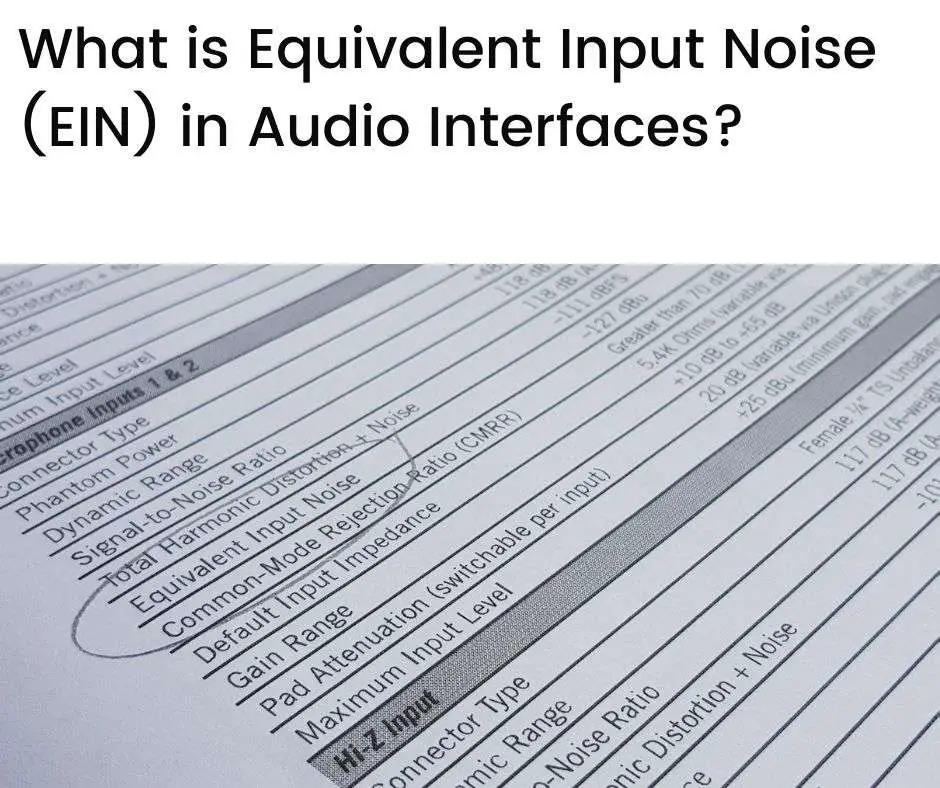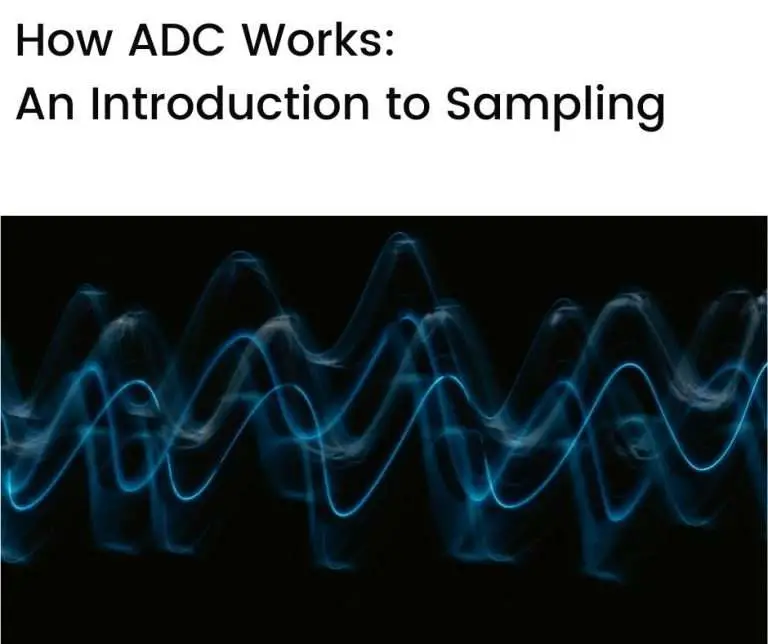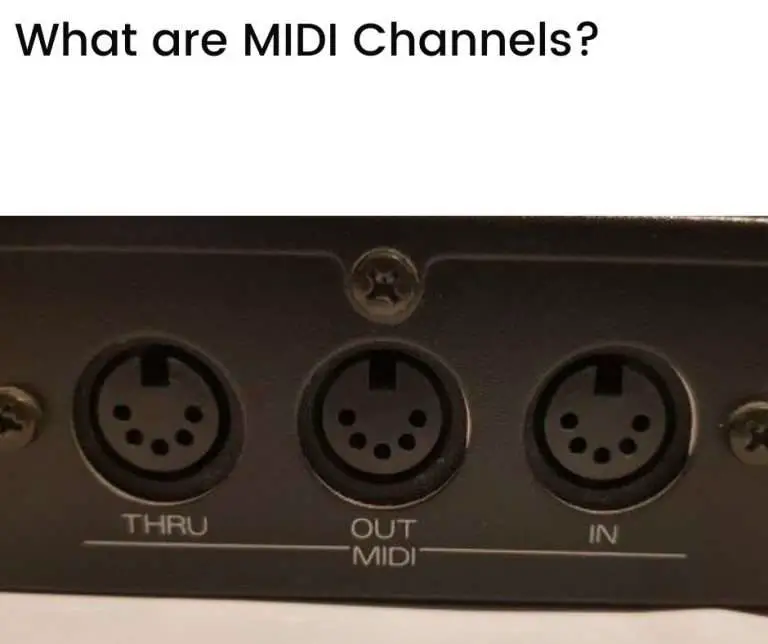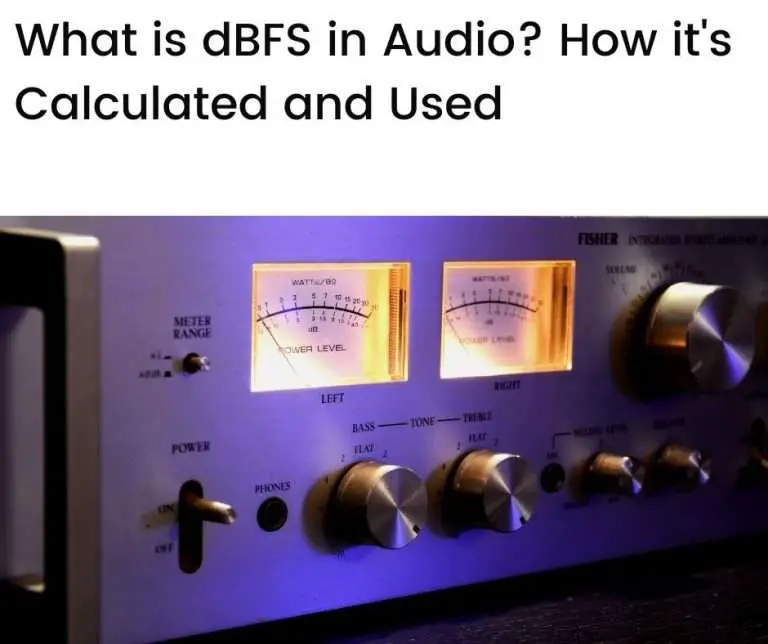Equivalent Input Noise, or EIN, is a measurement convention used for specifying noise levels in pre-amps. It is expressed in units of dBu or dBV and is quoted as a negative number. Typical values of EIN are in the range of -120 dBu to -129 dBu. EIN is an important consideration for audio interfaces that have built-in pre-amps, as even a small amount of noise can be problematic under the high gains that pre-amps use.
In this article we’ll look at:
- What is Equivalent Input Noise (EIN)?
- How is EIN measured?
- What causes noise in connected pre-amps?
- Why EIN is relevant for audio interfaces
- How EIN figures can be manipulated
- Conclusion
What is Equivalent Input Noise (EIN)?
Equivalent Input Noise, or EIN, is a measurement convention used for specifying noise levels in pre-amps.
EIN is a standard approach for measuring noise in pre-amps that allows for easier comparisons. This is helpful because there are many sources of inherent noise in pre-amps, and gains can vary widely, so a standardized approach makes like-for-like comparisons easier.
As the name suggests, EIN is a measure of the input noise in a pre-amp. It’s quoted as a negative value, and the lower the EIN (i.e., the larger the negative value) the better. An EIN of -129 dBu, for instance, is better than an EIN of -125 dBu (i.e., there is less noise produced by the -129 dBu pre-amp).
EINs are usually associated with mic pre-amps—in practical terms, they measure how much noise a mic pre-amp will add to a microphone’s own signal.
The idea behind focusing on input noise is to convey a sense of how much noise the pre-amp generates after adjusting for the impact of the gain applied—if this isn’t done, noise measurements would vary widely with varying levels of gain, making comparisons difficult.
How is EIN measured?
The basic approach for measuring a pre-amp’s EIN is:
- Connect a source resistance to the pre-amp
- Turn the pre-amp gain to a maximum level
- Measure the level of output noise generated
- Subtract the amount of gain from the measured noise level to determine the input noise, i.e., the EIN
When measuring the noise level that a pre-amp generates, it makes sense to connect a source to the pre-amp’s input terminals (i.e., measure the noise of a terminated input). This mimics the situation when a microphone is connected.
Without this, the noise that’s being measured would be for an unterminated input with a much higher impedance—this would provide false measurements.
Most EIN measurements use a standard 150 Ω resistor as the source resistance (although higher or lower resistance levels may also be used). The resistor is connected to the active conductors of a balanced cable, e.g., across pins 2 and 3 of a balanced XLR connector. This emulates a microphone as a source connection.
So, using a 150 Ω resistor and a gain of 60 dB, if the output noise was measured to be -65 dBu (see next section), then the EIN would be -125 dBu (=-65-60 dBu).
EIN measurement units (dBu and dBV)
EIN is usually expressed in dBu or dBV. These are both derived from dB, a common unit of gain measurement in audio systems.
While dB is simply a measure of the ratio between any two variables, dBu and dBV are specifically applied to measuring voltage ratios. Each has a reference voltage that they relate to.
dBu and dBV are calculated in a similar manner to dB, although noting the reference voltage in each case:
dBu = 20log10(V/V0.775)
dBV = 20log10(V/A1.0)
Where, V is the voltage level being measured in relation to a reference voltage of 0.775 volts in the case of dBu, and a reference voltage of 1.0 volt in the case of dBV.
From the above formula, there’s an easy way to convert between dBu and dBV:
dBu = dBV + 2.21 volts
You can see this from a few simple examples, as shown in the table below:
| Voltage Level Being Measured | dBu Calculation (volts) | dBV Calculation (volts) | Comparison (volts) |
|---|---|---|---|
| 100 | 20log10(100/0.775) = 42.21 | dBV = 20log10(100/1.0) = 40.00 | dBu = dBV + 2.21 |
| 20 | 20log10(20/0.775) = 28.23 | dBV = 20log10(20/1.0) = 26.02 | dBu = dBV + 2.21 |
| 6 | 20log10(6/0.775) = 17.77 | dBV = 20log10(6/1.0) = 15.56 | dBu = dBV + 2.21 |
| 1 | 20log10(1.0/0.775) = 2.21 | dBV = 20log10(1/1.0) = 0.00 | dBu = dBV + 2.21 |
In each case above, the relationship between dBu and dBV holds.
The below table summarizes how dBu and dBV are specified:
| Unit of Measurement | Reference Voltage | Relationship |
|---|---|---|
| dBu | 0.775 volts | dBu = dBV + 2.21 volts |
| dBV | 1.0 volts | dBV = dBu – 2.21 volts |
Typical EIN values
When measured using a 150 Ω source resistor, the theoretical minimum value of EIN is around -131 dBu—this is purely due to the thermal noise coming from the 150 Ω resistor (see next section).
Any additional noise coming from the pre-amp will only act to make the EIN worse (i.e., a smaller negative value, such as -128 dBu, for instance).
In practice, typical values of EIN (when measured properly) are in the range of -120 dBu to -129 dBu.
According to Hugh Robjohns, an industry-leading audio technician, -125 dBu is the minimum acceptable level for professional results (i.e., the EIN should be -125 dBu or lower, such as -128 dBu, for professional standards).
What causes noise in connected pre-amps?
Now that we’ve seen how EIN is measured, let’s take a closer look at exactly what types of noise are being measured.
All electronic components generate noise, including pre-amps.
For the purposes of EIN measurements, there are three main sources of noise generated by a (terminated) pre-amp:
- Thermal noise from the source resistance
- Voltage noise in the pre-amp
- Current noise in the pre-amp
The first source of noise comes from the source connected to the pre-amp (e.g., a microphone), while the remaining two are generated by the pre-amp itself.
Thermal noise, also called Johnson noise, arises due to the inherent thermal properties of resistive circuit elements.
Since for EIN measurements, a proxy source of a 150 Ω resistor is used, the Johnson noise coming from this will contribute to the source noise—it translates to around 3 dBu for a typical 150 Ω resistor under normal operating conditions.
The voltage and current noise added by the pre-amp arise due to the noise-generating properties of electronic circuits. These are unavoidable due to the physical properties of electronic components and the nature of flowing electric currents.
There may also be additional noise due to poor circuit design or external factors.
The way in which the source and pre-amp noise combine depends on how correlated they are. If they are generated independently of each other, then their total voltage noise will be the sum of squares of the individual voltage noises.
As mentioned, the EIN for a “noiseless” pre-amp, i.e., if the 150 Ω source resistor is the only contributor of noise, is around -131 dBu.
If we consider the case where the level of pre-amp noise is around the same as the source noise (i.e., 3 dBu), and if we assume that the pre-amp and source noise are generated independently, then the pre-amp will add a further 3 dBu noise to the system.
In this case, the EIN will be around -128 dBu (= -131 dBu + 3 dBu), and it would meet the minimum professional standards that Hugh Robjohns advocates (i.e., -125 dBu or less).
Why EIN is relevant for audio interfaces
Most audio interfaces come with in-built pre-amps that contribute to the total noise generated by the interface (if the pre-amps are in use).
When an audio interface has an EIN rating, this refers to the pre-amps included with the interface.
It’s worth keeping in mind that there are a number of sources of noise in audio interfaces—including noise generated by analog-to-digital conversion (ADC) and noise in circuitry—in addition to noise from pre-amps.
These different types of noise have varying origins—noise from ADC, for instance, relates to digital sampling parameters, whereas circuitry noise comes from the thermal and physical properties of electronic components.
As we’ve seen, pre-amp noise also arises from the inherent properties of electronic circuits and can be a significant consideration in audio interfaces. This is due to the high levels of gain that pre-amps apply to low-level input signals.
A gain of around 60-80 dB may be used, for instance, to boost a typical microphone signal—even a small amount of noise can be problematic when a high level of gain is applied to it.
How EIN figures can be manipulated
Manufacturers of audio interfaces usually specify the EINs of included pre-amps. As mentioned, the lower the EIN, the better.
Unfortunately, some manufacturers try to generate lower EINs by using adjustments to the standard measurement process.
Two common ways that manufacturers try to generate lower EINs are:
- Using a smaller source resistor—this contributes less source noise to the measurement calculation, resulting in a lower EIN
- Using A-weighting—this leads to smaller contributions from the high and low ends of the noise spectrum, resulting in a lower EIN
For these reasons, when comparing EIN measurements between manufacturers it’s worth paying attention to the measurement process that they use—artificially low values of EIN are a reason to be skeptical!
Conclusion
The Equivalent Input Noise, or EIN, is a measurement convention used for comparing noise levels in pre-amps. They are often quoted in the specifications for audio interfaces that include in-built pre-amps.
The standard approach for measuring EIN is to mimic a source resistance with a 150 Ω resistor, apply a gain on the pre-amp, measure the output noise, then subtract the gain to arrive at the EIN.
Noise in pre-amps comes from a variety of sources, but at a minimum, there will be noise from the electronic circuitry that makes up the pre-amp. This includes noise that’s inherent to the physical properties of the circuitry and noise generated by flowing electric charges.
EIN is measured in units of dBu or dBV. These are variations of dB, commonly used for measuring ratios, but are applied specifically to voltage ratios.
A theoretical minimum value of EIN is around -131 dBu. In practice, typical values of EIN are between -120 dBu and -129 dBu, while industry experts consider values of -125 dBu or less to be of a professional standard.
EIN figures may sometimes be manipulated by manufacturers to appear artificially low. This is done by adjusting the measurement process—using smaller source resistors or A-weighting, for instance—to generate lower EINs.
EINs are an important consideration in audio interfaces due to the high levels of gain that pre-amps apply (typically 60-80 dB)—even a small amount of noise can be problematic when a high gain is used.







